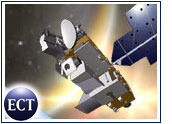
Most of us remember the scene in the 1977 movie “Star Wars” in which the robot R2-D2 projects a three-dimensional image of Princess Leia, who begs Obi-Wan Kenobi for help: “This is our most desperate hour. Help me, Obi-Wan Kenobi. You’re my only hope.” Seeing that film years ago planted the desire in many of us to see this kind of technology brought to life. After all these long years of waiting, portable holography has finally arrived.
IO2 Technology announced that it has completed a working prototype of what the company is calling the Heliodisplay, a three-dimensional display that uses no screen whatsoever but can project TV, video and computer images into free space. The company’s technology makes it possible for users to walk around — or even through — the floating images projected into air.
The unit, which is about the size of a bread box, can project images as large as 27 inches and will have the ability to expand to 150 inches with future releases. As far-fetched as it sounds, the device has interactive capabilities as well. Images can be manipulated just as though they were displayed on a conventional computer monitor, but instead of using a mouse, a viewer can use a hand to move an image or a finger to move the cursor and select an object.
“With the launch of Heliodisplay, IO2 Technology is pleased to open a new frontier in video display technology,” said Chad Dyner, founder and CEO of the Hermosa Beach, California company.
Display Evolution
A major change in the display market happened when the bulky three-dimensional CRT was slimmed down into the two-dimensional flat-panel display. Now, the rectangular screen has collapsed into a single line. While LCD displays do not offer the same kind of color quality or refresh rates that standard CRTs do, the industry seems to have taken a liking to the flat panels for their size and weight advantages. The same might happen with virtual displays — like the Heliodisplay.
The initial prototype of the Heliodisplay — which has not yet gone into mass production — projects a 5-inch diagonal 1,024 x 768 image into the air. The prototype is capable of 16-bit color video and allows for controllable opacity. It is easiest to understand how this technology works by seeing it in action.
According to the company, the main limitation on the image is the vertical dimension. As long as the device contains one solid horzontal edge to produce the particle cloud — onto which the image is projected — there are no limitations in length.
Imagining Markets
By placing an object, such as a hand, in the particle stream, users can locally disrupt the image, but the object’s position can also be detected optically, and the image can be changed appropriately — which means that the Heliodisplay could be used interactively. It also means that multiple users could manipulate the image collaboratively.
It is easy to see the many potential applications for this kind of technology. “Initially, this kind of display is best for creating virtual prototypes that can be viewed from all sides with huge design implications from product to architecture,” Enderle Group analyst Rob Enderle told TechNewsWorld.
“In sales situations it could reduce the need to carry samples dramatically and provide a much better way to view products that have not yet completed the manufacturing cycle — potentially increasing the initial volume sales ramp-up of a new offering,” Enderle said.
Moving Ahead
“We see potential near-term demand in video gaming, retail, advertising and — if we can refine the technology — as an alternative to traditional displays like CRT, flat screen and plasma,” Robert Moulton-Ely of IO2 Technology’s business development division told TechNewsWorld.
“It is conceivable that existing display technology will be considered ‘nonstandard’ once this technology reaches market saturation,” he said.
Moulton-Ely pointed out that the Heliodisplay is a one-of-a-kind, hand-built prototype. “There aren’t any shrink-wrapped boxes in a warehouse ready to be shipped,” he said. “But if you see it, and even accounting for all the issues surrounding it being a hand-built prototype, you will be amazed.”
While the company doesn’t have a price firmly established, Moulton-Ely estimates the components to cost roughly US$5,000 at retail. “So, mass produced,” he said, “we expect the price point to be dramatically less.”
“Our next objective,” said IO2 Technology’s Dyner, “is to identify a partner with whom we can ready the device for continued advancement as well as for full-scale manufacturing and distribution.”





















































